A Nicholas Taber Panel Raising Plane--with a Story.
This note stems from a woodworking plane purchased at
a Rhode Island tool auction. The plane was made by Nicholas Taber, who was an
early New Bedford plane maker living before 1800 in Fairhaven, across the
Acushnet River from New Bedford. Nicholas was the father of another plane maker,
John Marshall Taber. John M. Taber made planes in New Bedford for over 50 years
(1822 – 1873), apparently at the same location -- 20 Elm Street--across the foot
of Elm Street from the current Standard-Times building.
Nicholas Taber was not as prolific a plane maker as
his son, but is perhaps better known in local history since his interests and
achievements were more catholic. For example, he is listed as one of the "Proprieteri"
of the "New Bedford Academy" (in what is now Fairhaven) founded in May, 1800. He
was given the task of visiting this early school at regular intervals in order
to ensure that it was being maintained and run effectively.
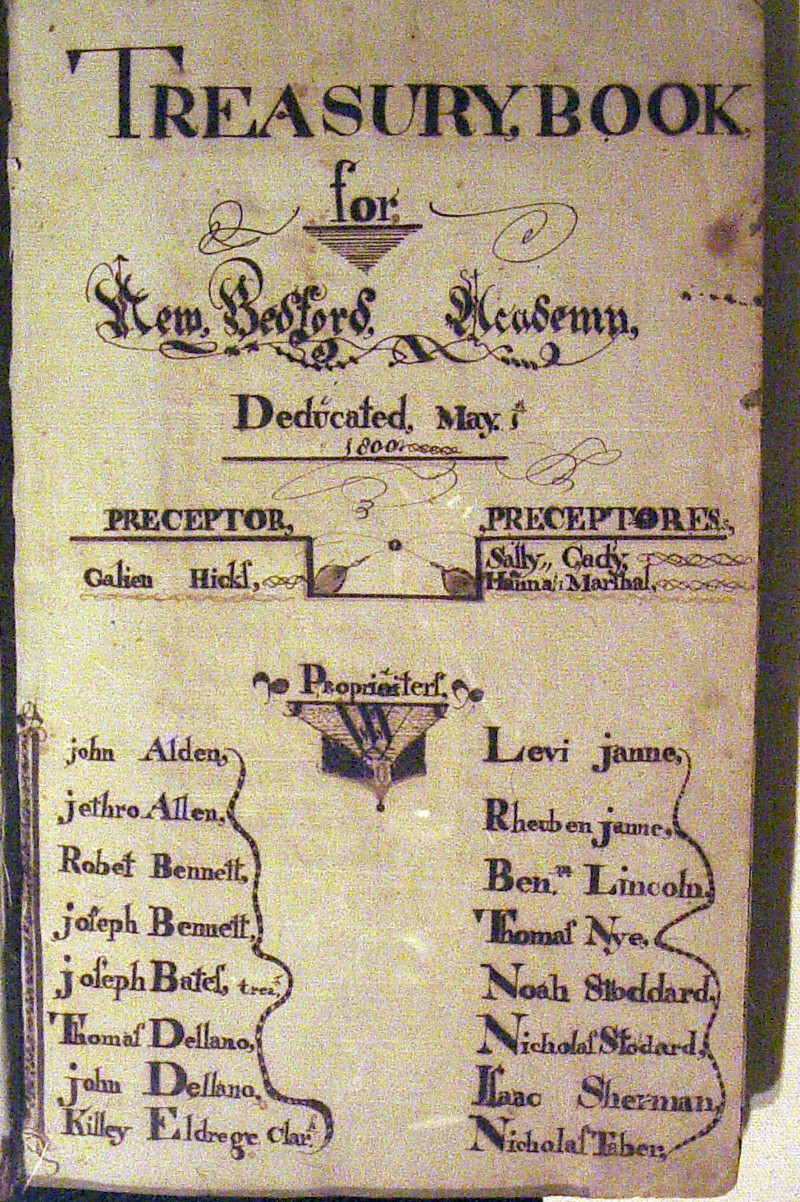
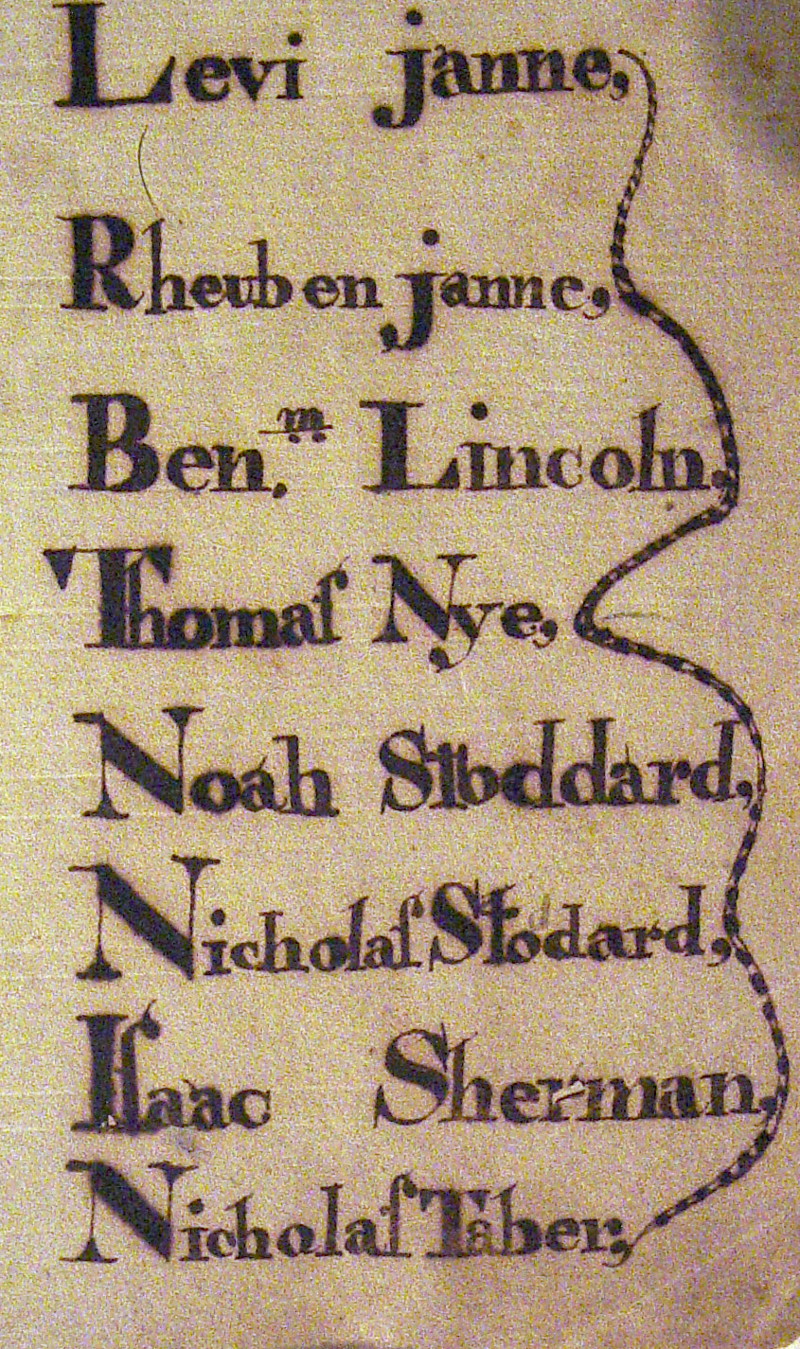
He later served as treasurer for the school, and kept
the ledger pictured above. Before this he is listed in the school’s account book
as having sold "moulding shaves" (for $0.50) to the school.
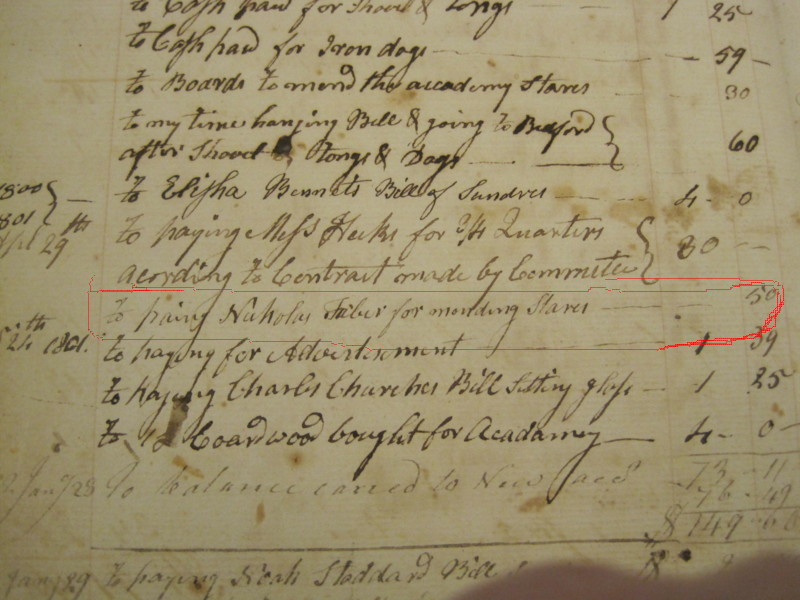
At some point he converted his Fairhaven home (which
still stands) into an inn—the Sunrise Inn—and there are records of a liquor
license being awarded to him. The sign that graced this inn still exists. It is
noteworthy in that the font and style of his name on the sign , "N .
Taber" mirrors that with which he marked his planes.
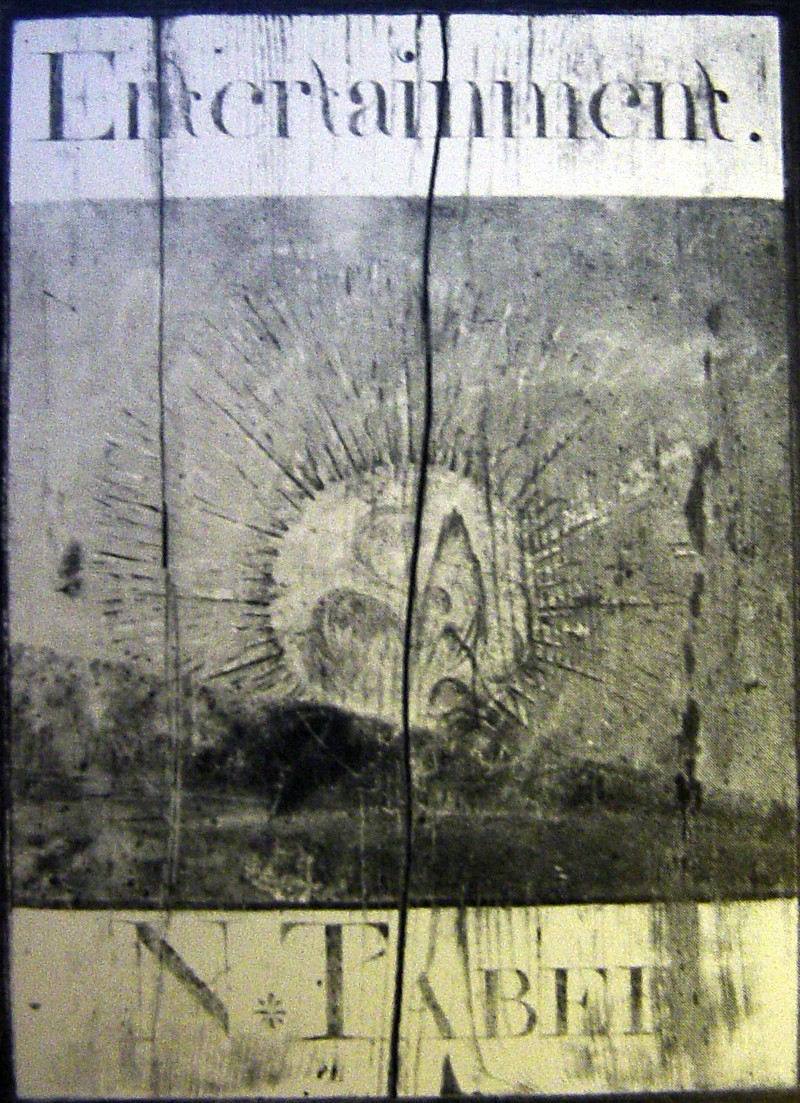
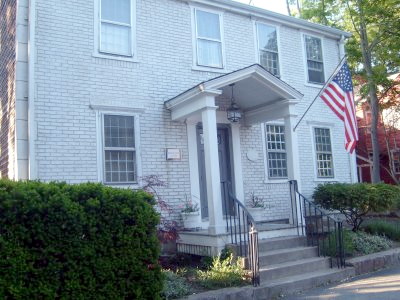
Taber lived from 1761 to 1849. While his earliest
planes were made about 1785 in Fairhaven, at some point he moved his shop to the
New Bedford side of the Acushnet River. Perhaps this occurred as early as 1797
when a bridge was first built across the estuary, connecting the Fairhaven side
to the New Bedford side (then known as "Bedford Village". By about 1820 he was
out of the plane making business and had given his shop to one son, John M.
Taber, and his tools to a second son, Allen Taber. By 1830 Allen had moved to
Augusta, Maine, where he apparently made planes, but no marked examples have
been reported. John M. Taber went on to become New Bedford’s most prolific plane
maker, and an important teacher of apprentices in the art and craft of plane
makers. However, he seemingly never achieved the social record of his father,
and consequently we know relatively little about him.
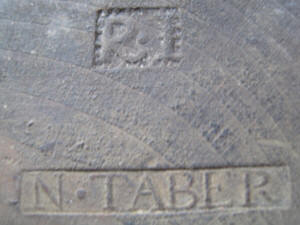 A
second reason for my purchase of this plane was that it is a style of plane
known as a "panel raiser." This is a plane used to "raise" panels that are inset
as design elements into doors and larger furniture such as cabinets and shelving
units. The center of such a panel is "raised" above the edges with wide chamfers
of those edges, terminating in shallow tenons that are fitted into the
horizontal and vertical grooves surrounding the panel. The backs of these panels
are often chamfered with other tools, such as bench planes, draw knives, shaves,
or chisels, but special panel raising planes are used on the fronts of the
panels to provide a consistency from one edge to another that is difficult to
achieve with ordinary planes or other tools. Because two of the edges of a panel
require cutting across the grain of the wood, panel raising planes commonly have
blades bedded in a skewed position. This facilitates cross-grain planning. Panel
raising planes are not particularly common, but are favored planes of today’s
woodworkers who desire to raise panels the "old fashioned way."
A
second reason for my purchase of this plane was that it is a style of plane
known as a "panel raiser." This is a plane used to "raise" panels that are inset
as design elements into doors and larger furniture such as cabinets and shelving
units. The center of such a panel is "raised" above the edges with wide chamfers
of those edges, terminating in shallow tenons that are fitted into the
horizontal and vertical grooves surrounding the panel. The backs of these panels
are often chamfered with other tools, such as bench planes, draw knives, shaves,
or chisels, but special panel raising planes are used on the fronts of the
panels to provide a consistency from one edge to another that is difficult to
achieve with ordinary planes or other tools. Because two of the edges of a panel
require cutting across the grain of the wood, panel raising planes commonly have
blades bedded in a skewed position. This facilitates cross-grain planning. Panel
raising planes are not particularly common, but are favored planes of today’s
woodworkers who desire to raise panels the "old fashioned way."
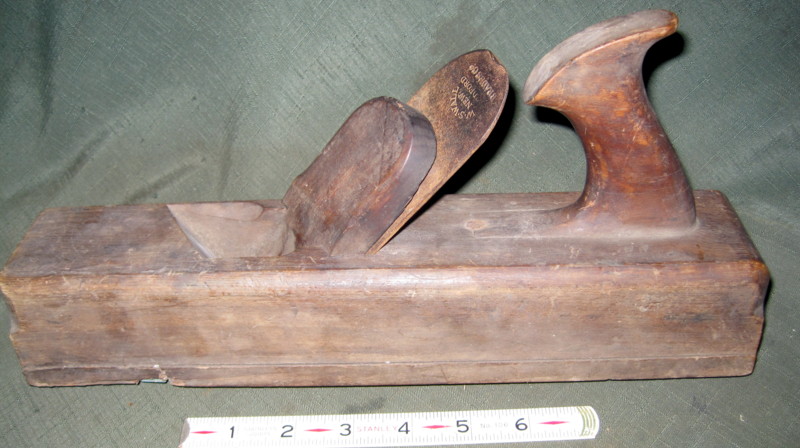
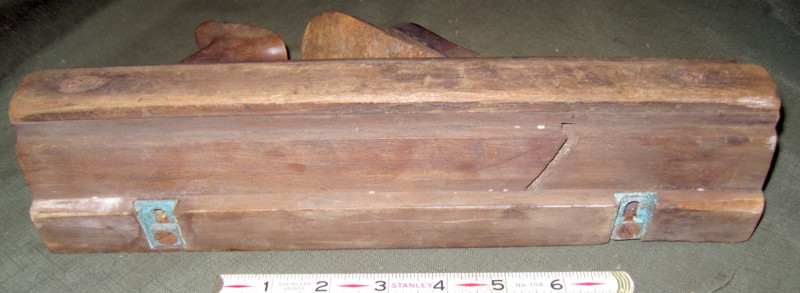
The plane is a fairly small panel raiser. It is 13
inches long, with a body that is 2 ¾ inches wide. It has a skewed blade, held by
a wedge that has a rounded "tombstone" shape with slightly chamfered edges. The
plane is made of American beech, and the top of the body has rounded chamfers.
There is an applied "fence" on the right side, and an adjustable fence screwed
to the left side of the sole. This allows its use on raising panels of various
sizes—but most of its use would have been on smaller panels, typical of
furniture rather than full door sizes. The plane has a handle known as an "open"
tote, which is centered on the width of the body. The totality of the features
of this plane suggest one that was made about 1800, which by American standards,
is a relatively early plane.
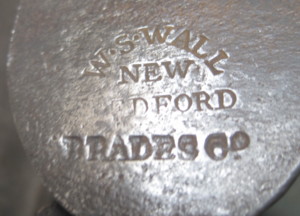 When
I returned home with the plane (which is dirty and dusty—this patina should
never be removed from an early plane), I found that the blade was marked, "Brades
Co." with a deep "hot stamp" mark that is upside down as you look at
it. Incidentally, Nicholas Taber also marked his planes on their fronts (toes)
with an upside down mark—as did his son, John M. Taber). But over this mark on
the blade , was another, lighter, cold-stamped one that reads, "W.S. Wall" in an
arc, and "New / Bedford."
When
I returned home with the plane (which is dirty and dusty—this patina should
never be removed from an early plane), I found that the blade was marked, "Brades
Co." with a deep "hot stamp" mark that is upside down as you look at
it. Incidentally, Nicholas Taber also marked his planes on their fronts (toes)
with an upside down mark—as did his son, John M. Taber). But over this mark on
the blade , was another, lighter, cold-stamped one that reads, "W.S. Wall" in an
arc, and "New / Bedford."
Now, in 15 or 20 years of looking for tools related to
New Bedford tool makers, I’ve never seen the mark of one "W.S. Wall." So, I
called Michael Humphrey who has an extensive collection of wooden planes,
including a number of those made by Nicholas Taber. Mike confirmed that this
must be a very uncommon mark, and could recall no Taber plane in his collection
with a similar one.
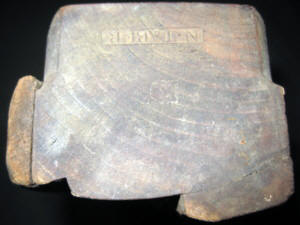 At the same time he asked if this panel raiser had a sole that was slightly
convex in its cross-sectional outline. The answer is "yes", this plane has a
convex sole. He pointed out that this is fairly unique to N. Taber planes, and
would produce chamfers on the panel edges that are slightly concave—different
from the flat chamfers found on most panels. This would make possible the
identification of a panel, in an early New Bedford piece of furniture or door,
as likely having been made by Nicholas Taber plane.
At the same time he asked if this panel raiser had a sole that was slightly
convex in its cross-sectional outline. The answer is "yes", this plane has a
convex sole. He pointed out that this is fairly unique to N. Taber planes, and
would produce chamfers on the panel edges that are slightly concave—different
from the flat chamfers found on most panels. This would make possible the
identification of a panel, in an early New Bedford piece of furniture or door,
as likely having been made by Nicholas Taber plane.
So, now the next question for me was, "Who was W.S.
Wall" that marked tools with this stamp about 1800? The answer was not long in
coming. A Google search for "’W.S. Wall’ New Bedford" turned up just a few hits,
and one of these was a reference to an Ohio historical site (
http://www.massillonmemory.org ), which
operates out of the Massillon, Ohio Public Library. This site contains a
digitized letter written in 1802 from one "Wm. Sawyer Wall" in New Bedford to
Thomas Rotch, perhaps living near Hartford, Conn. Both Wall and Rotch are names
firmly embedded in New Bedford history. The family name, "Rotch"(pronounced,
Roach) is notable for the father and son team of William Rotch, Sr. & Jr., who
moving to New Bedford from Nantucket after the Revolutionary War, were
instrumental in establishing the city as the pre-eminent American whaling port
in the 19th Century.
Thomas Rotch (a brother of Wm. Rotch, Jr.) came from
his ancestral home in Nantucket about 1790 to marry Charity Borden Rodman, a
resident of Newport, RI. The couple then moved first to Nantucket. After
their first (and only) child died, they moved to New Bedford about 1792. Here
Thomas joined his brother, William Rotch Jr, in a whale oil and spermaceti
candle business. He is recorded as being one of the preceptors (and treasurer)
of the New Bedford—Fairhaven bridge, built in 1797. This is the bridge that
Nicholas Taber probably walked or rode across each day to make planes. In 1800
Thomas and Charity moved west to the region of Hartford, Connecticut, and Thomas
established farms for raising sheep, an "oil mill," and a mill to manufacture
woolen cloth. His intentions were to operate as a Missionary for his Quaker
faith. This is when Wm. S. Wall, sold the scythes to Rotch, and asked for
further references and help.
The letter written to Thomas Rotch by Wm. Sawyer Wall
reads as follows:
New Bedford 3 Mo, 23, 1802
Thomas Rotch
Bot [bought] of Wm. Sawyer Wall
3 patent Cast Steel Scythes @ 13/
-----------------------$ 6.50
Esteemed Friend,
Agreeably to thy intimation I now forward the
above to thy care: and hope that they will not only be reliable but give
satisfaction to the purchaser.
Should the quality prove such as to cause
persons in your neighborhood to be solicitous of procuring them: on
information I can undertake to have them made in any pattern. I shall be
obliged to provide them with little trouble.
If thou wouldst provide with me as much
broom-corn as is sufficient to make 20-30 brooms and send by Captain
Delano on his return, I propose sending it to England to a person who
informs me he can find a market for a great quantity annually should it
answer the description he has had of it. But prior to giving any order
he wishes to have a specimen of it. Please likewise to inform me of the
terms on which it is sold & whether by weights or otherwise.
I have thy press nearly finished but having
sold my vise, I have not been able to complete it to send this trip, but
hope to do it by next.
My affectionate remembrances to thy Wife
remains
Thy Friend
W.S. Wall
This letter contains a lot of information about Wall
(and Rotch). First, Wall is marked as both "W.S. Wall", and ‘Wm. Sawyer Wall."
So this is almost surely the "W.S. Wall" who marked the plane blade. The
approximate date of the plane (ca 1800), and the letter (1802) agree in this
regard. Next, Wall is billing Rotch for three scythes that he had shipped to
him, ostensibly via a vessel whose master was one, "Captain Delano." There is
also a concordance here, between the sorts of goods involved, plane
blades and scythes (edge tools). But, it is also possible that Wall may not have made the
scythes. They are described as "patent" scythes, and Wall can "provide" (not
"make") them. And, Wall did not necessarily make the plane blade. He put his
mark on the blade, but it is also marked, "Brades Co"—the firm that probably
made the blade.
At time of this letter, Rotch was living near
Hartford, Conn. The Massillon, Ohio, Historical Society owns a trove of at least
996 letters to and about Thomas Rotch, from the early 1790s, until his death in
1823. John Bullard drew upon this trove of letters for his book, "The Rotches",
(published in 1947 by The Cabinet Press, Milford, NH). It seems that he moved to
this region of Ohio from Hartford in 1811 in order to establish farms dedicated
to sheep husbandry, and for reasons of Charity's health--she suffered from
Spotted Fever, contracted in Connecticut. Wall’s request for "broom straw"
confirms that Rotch was living in a farming region, such as near Hartford. The
information that Captain Delano was delivering the scythes and carrying the
broom straw is feasible, given that Hartford is below the head of tide on the
Connecticut River, which was fully navigable by sailing ships to that point.
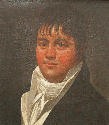 The
Captain Delano mentioned in this letter probably refers to Captain Calvin Delano
who was a Fairhaven resident about this period. I once owned a ledger that
belonged to a Fairhaven cobbler named Jethro Delano, who as early as 1802 made
shoes for Captain Calvin Delano. Captain Calvin Delano was a merchant seaman who
carried goods along the east coast, and across the Atlantic to Europe. Indeed,
still as a young man, he died in St. Petersburg, Russia while on a voyage. The
New Bedford Whaling Museum owns a portrait of him. Of course, the Captain Delano
mentioned in Wall’s letter could have been a different "Capt. Delano." Two other
possibilities include Capt. Seth Delano, and Capt. John Delano, both of whom
also appear in Jethro Delano’s ledger.
The
Captain Delano mentioned in this letter probably refers to Captain Calvin Delano
who was a Fairhaven resident about this period. I once owned a ledger that
belonged to a Fairhaven cobbler named Jethro Delano, who as early as 1802 made
shoes for Captain Calvin Delano. Captain Calvin Delano was a merchant seaman who
carried goods along the east coast, and across the Atlantic to Europe. Indeed,
still as a young man, he died in St. Petersburg, Russia while on a voyage. The
New Bedford Whaling Museum owns a portrait of him. Of course, the Captain Delano
mentioned in Wall’s letter could have been a different "Capt. Delano." Two other
possibilities include Capt. Seth Delano, and Capt. John Delano, both of whom
also appear in Jethro Delano’s ledger.
It is clear that Thomas Rotch had some sort of
personal as well as business relationship with Wm. S. Wall. Both were obviously
Quakers, and Wall evidently knew Rotch’s wife. About 1800 the population of
greater (including Fairhaven) New Bedford was probably not much more than 1000
people, and since the Quaker community was a tight knit one, it is not
surprising that they would have known one another..
Wm. S. Wall emerges from this letter as a merchant. He
sells patent scythes, and is interested in establishing trade with partners in
England that involve brooms or raw broom straw. Moreover, he apparently
contracted to supply a "press" to Rotch. And we know that, whatever kind of
"press" it was, he was involved in its manufacture, which required a vise that
he had sold. So, in addition to his life as a merchant, he must have had some
mechanical skills.
In today’s New Bedford, Wm. Sawyer Wall is best known
as the father of artist William Allen Wall. Wm. Allen Wall was born in
1801, about a year before his father penned the letter to Thomas Rotch. By the
1850s the junior Wall was a prolific New Bedford artist painting
historically--based landscapes in and around New Bedford. One of his most famous
paintings, which has been printed many times, is known as "Old Four Corners, New
Bedford," or "New Bedford in 1807." Another iteration, apparently later, is
titled, "New Bedford, Fifty Years Ago." The scene is looking west, up Union St
(then known as Main Street) from just southeast of the corner of the present day
Union and Water Streets. The original painting dates to about 1855, and a
lithograph made in 1858 contains the additional figures added by 1857. It is
supposed to have been based on a sketch made by Wall’s father (Wm. S. Wall) 50
years earlier. The painting originally was created with depictions of
historically important figures in action at the cross roads (including the
Rotches). Later, additional
figures were added to the picture, and in an interview about 1859, Wall
identified many of them. A notable is one is a young child riding a cart being
pulled by other children. It is speculated that it was meant to portray himself
as a child of six years old when the picture was sketched by his father. Also
shown is another figure, talking to a gentleman leaning against a wall on the
right side of the intersection. Wall meant this to be his father, standing at
the corner, talking to the other person leaning against a wall. This, then, is a
portrayal of Wm. Sawyer Wall, the man who applied his name stamp to the blade on
my plane.
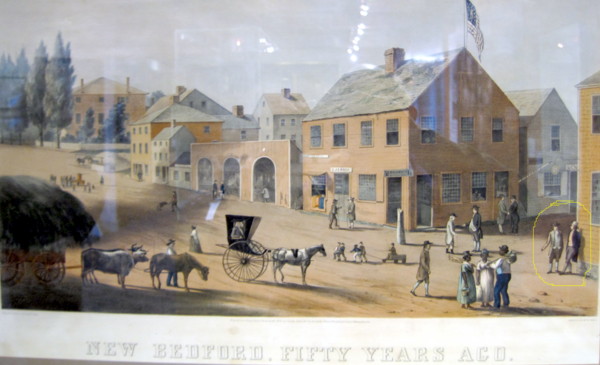
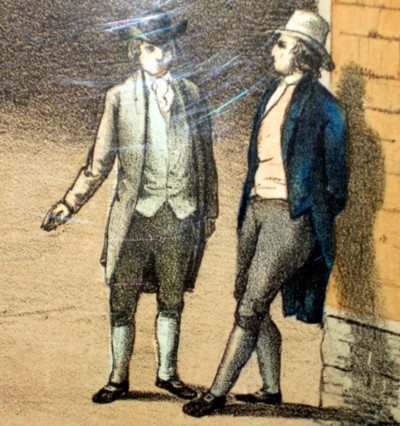
It is interesting that in the historical traces of Wm.
Sawyer Wall, he is most famous for being the father of his artistic son. But, in
Mary Jean Blasdale’s "Artists of New Bedford" he is also mentioned in
respect to having taught school, and as being a "pedagogue." Perhaps his
interest in education caused him to interact with Nicholas Taber, who, after
all, was involved with the New Bedford Academy. Wall is also credited with
have drawing or artistic skills that might have been passed down to his son.
Finally, he is described as being a "merchant," and running a hardware store.
This is the side of him that we see in the plane blade, and in his letter to
Thomas Rotch. Wm. Sawyer Wall died in 1815.
It is probable that Wm. Sawyer Wall did not make the
blade that bears his name. The stamp reading "Brades Co." is surely the one of
the maker. Brades Co. was a very old and long lived firm that mined coal and
iron ore in Oldbury, England (near Birmingham) from well back into the 18th,
or even 17th Centuries. Their steel products included hammers and
chisels, and there are reports of plane blades made by them—but examples (except
for the present one) are not forthcoming. Surely, with his English business
connections (and Wm. Sawyer Wall was born in England), he would have imported
his plane blades from that country. In the late 18th century,
American-made cast steel plane blades were not available, either in New Bedford,
or elsewhere in the fledgling U.S. and most plane makers used blades made in
England.
Thomas Rotch led a life that had its remarkable
aspects. Leaving Hartford about 1811, he and Charity took a circuitous route
through western Massachusetts and eastern New York, and riding on horseback,
they then circled down through Ohio, going as far south as Columbus, and then
coming north to about 40 miles south of Akron. Here they stopped and purchased
2500 acres of land, laying out and settling the town of Kendal. There he
established a herd of purebred Merino sheep that a helper had driven from
Hartford, and ultimately built woolen mills for the production of high quality
cloth. He was the first post master of Kendal. Kendal today comprises part of
Massillon, Ohio, and Thomas Rotch is known as the founder of Massillon.
Continuing their missionary work in Kendal, Thomas and
Charity gave succor to escaped slaves coming north through Ohio. Living on the
edge of Indian Territory, Thomas was also active on the Society of Friends’
Indian Affairs Committee. Thomas and Charity were magnets for other Quakers
wanting to move to the frontier, and they were joined by a number of families
that originated from Nantucket.
Thomas Rotch died in 1823 (at a Quaker Annual
Meeting in Mt. Pleasant, Ohio) at the age of 56. The whereabouts of his
grave is unknown. Charity died one year later. In her will she left about
$20,000 for the establishment of a residential school for orphaned children, and
children "of depraved parents." That school (in her name) continues today as
"The Charity School of Kendal in Massillon, Ohio."
For any tool collector, finding a story behind a tool
is part of what makes this avocation so interesting. The story behind this
Nicholas Taber panel raising plane has been a particularly fulfilling one, and
I’ll treasure this plane for a long time.
A
second reason for my purchase of this plane was that it is a style of plane
known as a "panel raiser." This is a plane used to "raise" panels that are inset
as design elements into doors and larger furniture such as cabinets and shelving
units. The center of such a panel is "raised" above the edges with wide chamfers
of those edges, terminating in shallow tenons that are fitted into the
horizontal and vertical grooves surrounding the panel. The backs of these panels
are often chamfered with other tools, such as bench planes, draw knives, shaves,
or chisels, but special panel raising planes are used on the fronts of the
panels to provide a consistency from one edge to another that is difficult to
achieve with ordinary planes or other tools. Because two of the edges of a panel
require cutting across the grain of the wood, panel raising planes commonly have
blades bedded in a skewed position. This facilitates cross-grain planning. Panel
raising planes are not particularly common, but are favored planes of today’s
woodworkers who desire to raise panels the "old fashioned way."
 The
Captain Delano mentioned in this letter probably refers to Captain Calvin Delano
who was a Fairhaven resident about this period. I once owned a ledger that
belonged to a Fairhaven cobbler named Jethro Delano, who as early as 1802 made
shoes for Captain Calvin Delano. Captain Calvin Delano was a merchant seaman who
carried goods along the east coast, and across the Atlantic to Europe. Indeed,
still as a young man, he died in St. Petersburg, Russia while on a voyage. The
New Bedford Whaling Museum owns a portrait of him. Of course, the Captain Delano
mentioned in Wall’s letter could have been a different "Capt. Delano." Two other
possibilities include Capt. Seth Delano, and Capt. John Delano, both of whom
also appear in Jethro Delano’s ledger.
The
Captain Delano mentioned in this letter probably refers to Captain Calvin Delano
who was a Fairhaven resident about this period. I once owned a ledger that
belonged to a Fairhaven cobbler named Jethro Delano, who as early as 1802 made
shoes for Captain Calvin Delano. Captain Calvin Delano was a merchant seaman who
carried goods along the east coast, and across the Atlantic to Europe. Indeed,
still as a young man, he died in St. Petersburg, Russia while on a voyage. The
New Bedford Whaling Museum owns a portrait of him. Of course, the Captain Delano
mentioned in Wall’s letter could have been a different "Capt. Delano." Two other
possibilities include Capt. Seth Delano, and Capt. John Delano, both of whom
also appear in Jethro Delano’s ledger.